My day with butter cows
August 17, 2011—
DES MOINES, Ia.—-If it had been up to me I would have carved Southern Belle-isious chef Paula Deen out of a block of butter at the Iowa State Fair.

But like an ambitious diet, or big workout program it wasn’t meant to be.
I was invited to be a ringer in Monday’s “Battle of the Butter,” held daily on the fairgrounds in conjunction with the 100th anniversary of the fair’s fabled butter cow.
I absolutely love the Iowa State Fair, which runs through Aug. 21. I love pork chops on a stick, red velvet funnel cake and the smell of livestock. I attended the “Nostalgic Comfort Food” competition sponsored by the Brass Armadillo Antique Malls. The Iowa State Fair is the only Iowa destination in the New York Times best selling travel book “1000 Places to See Before You Die.”
And too much butter can do that trick.
I was placed on a three-person team of graphic design teachers from the Des Moines Area Community College (DMACC) who came up with a “Butterly on Butter Toast” concept. I could see we were in trouble with the bag full of props such as paper butterfly wings and beady eyes.
Butter is best unprocessed.

We had a half hour to carve our sculpture. I patted down some of the buttery base, steadied the butterfly block and installed some wire antenna.
Most of alI I tried to stay out of the way.
I was amazed the pavilion at the Riley Stage was full to watch us compete with two other teams. Based on the audience response of about 350 butter fans, we finished third.
That would be last.
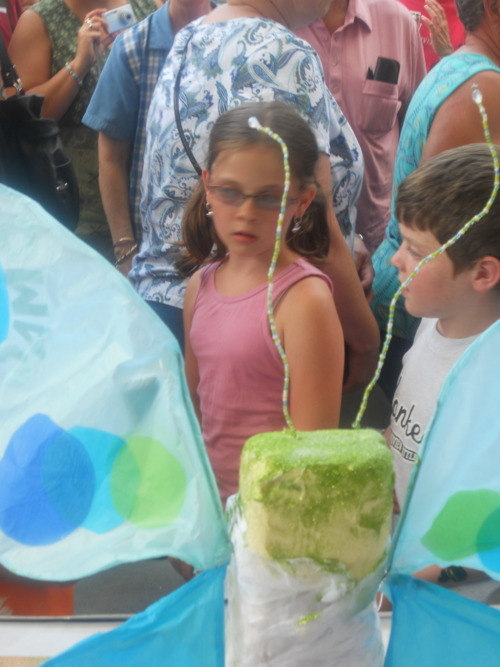
At least kids were amazed. (Photo by D. Hoekstra)
We did take home nice yellow third place butter cow ribbons and it seemed we were the people’s choice for those under eight who had no reference point to the winning Grant Wood “American Gothic” influenced sculpture. There was more bling to our butter.
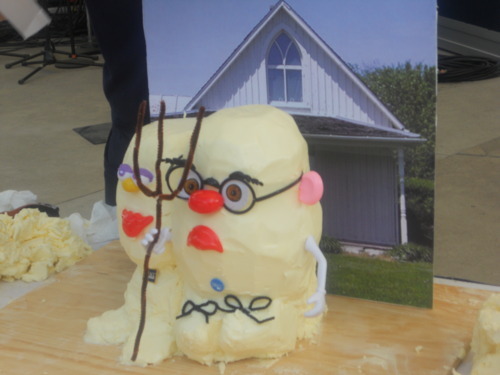 .
.
The daily winning entry gets to be displayed alongside the butter cow in the Agriculture Building’s showcase cooler.
That’s where earlier in the day I went backstage with Sarah Pratt, the state fair’s fourth butter sculptor in 100 years. The butter cow is the biggest attraction at this year’s state fair. Lines to view Pratt’s work are longer than usual for three reasons:
· The anniversary celebration.
· The new turning mechanism to display the sculpture from all sides.
· And the late-June passing of Norma “Duffy” Lyon. The “Queen of the Butter Sculptors” died of complications from a stroke. She was 81. Duffy was the first woman sculptor in the history of the state fair.

Norma Lyon with her first butter cow, 1960 (Courtesy of Iowa State Fair)
Pratt, 26, apprenticed with Duffy for 15 years until 2006 when she officially assumed the queen’s throne.
Duffy retired in 2006 after 46 years of sculpting. Her nickname is derived from her maiden name of Duffield. Duffy’s uncle Phil Stong wrote the 1932 novel “State Fair” of which the smash Rodgers & Hammerstein musical was based. The setting is the Iowa State Fair. Stong once described his muse for writing: “Fell while trying to clamber out of a low bathtub at the age of two. Became a writer. No other possible career.”
Short sentences stand tall in Iowa.
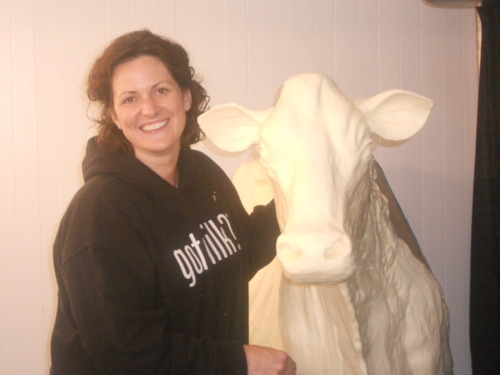
Sarah Pratt, butter cow sculptor (Photo by D. Hoekstra)
In the past Pratt has depicted Superman of “Superman Returns” fame (in honor of actor Brandon Routh of Norwalk, Ia.) and Bill “Mr. State Fair” Riley in tribute to attending his 60th state fair.
Now I’ve been to two Iowa State Fairs. And three Illinois State Fairs, where they have a 400-pound butter cow.
This year Pratt sculpted a cow , boy and calf, which replicates the 1911 sculpture by J.E. Wallace of Florida. Pratt added a young girl as a tribute to Duffy.
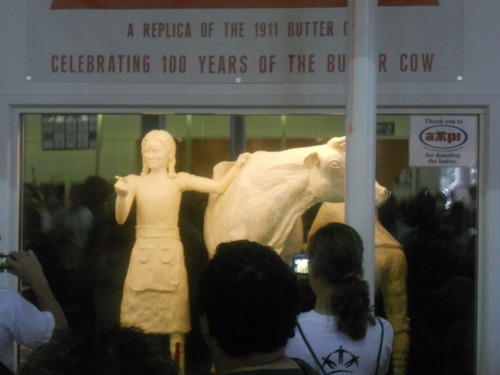
Pratt works off of sketches and photographs. “I had one post card of the 1911 cow,” she said on Monday while touching up her work with a wood spreader. “I had only one perspective which was a challenge to get a three dimensional work.
Pratt carved the 1911 farm scene from 850 pounds of butter. It sits across the showcase from the traditional butter cow made with 500 pounds of butter.
To put all that in perspective, a 600 pound butter cow would butter 19,200 slices of toast. The Midwest Dairy Association has provided all the butter for the state fair since 1960.
Pratt and Duffy attended St. Patrick’s Catholic Church in Toledo, Ia. (pop. 1,500) at the same time. “I knew her since I was four,” Pratt said. “My parents went to school with some of her kids.” Duffy raised nine children and countless Jersey cows with her husband Joe. “I was in 4-H and when I was 14 my friend Kari Lyon (Duffy’s great niece) invited me to spend a night in the cattle barn at the Iowa State Fair,” Pratt recalled.
Did I tell you I love the Iowa State Fair?
“She was showing dairy,” Pratt continued. “And while she was showing her dad and uncles sent me here to work in the butter cooler. That was the first year I worked with Norma in any butter sculpting sense. In 2005 she told me she was retiring. She already told the fair I was taking over. So I had to do it.”
Pratt had reservations about assuming the position. There was little margarine for error.
“When you’re sculpting in the cooler as an apprentice there weren’t many parts of the sculpture you had done without anyone else affecting it,:” she explained. “To do it by yourself was something to be tested. I wasn’t sure. How much did she come back behind me and switch things?’
Pratt said Duffy chose many of her own butter cow themes: Elvis Presley, Jesus at the Last Supper, and Tiger Woods, which turned out to be her final butter cow,.
Pratt is a quintessential Iowa woman. She lived on a farm until the age of three. Pratt paints and teaches elementary school in West Des Moines. “Last year I did ‘Green Eggs and Ham,’ so I read the (Dr. Seuss) book the first day of school and showed the kids the sculpture,” Pratt said.
She has twin 7-year-old daughters with her husband Andy who works for an insurance company.
“I wasn’t sure I could continue with two little ones at home,” she said. “But I got talked into it. That was 2004. I sculpted Norma, She didn’t want to sculpt herself, That was the first thing I did without anyone else affecting the work. Then in 2006 I did my first cow without her.
” I was lucky to have her around the first couple of years to give me pointers to make my work better. I’d go to the farm and she’d show me the cows. Her family still did that for me this summer. Her grandson Todd Lyon in a junior at Iowa State and he’s been helping me since his grandmother retired.”
“I love that connection.”
In something that is completely wrong, on the day before my visit animal rights activists snuck in the cooler and posted a “Go Vegan” sign around the butter cow’s neck.
According to the Des Moines Register the activist’s accompanying statement said in part, “The butter cow represents humankind’s tyranny over defenseless animals.”
Come on.
“I didn’t lock the (cooler) door,” Pratt said. “Before this I could just come and go. To give it a positive spin they came here (instead of hassling real animals!) to get the most publicity. The sign was here before the buiilding was open and they caught it early in the day. I was at church and got the phone call and it was already taken care of.”
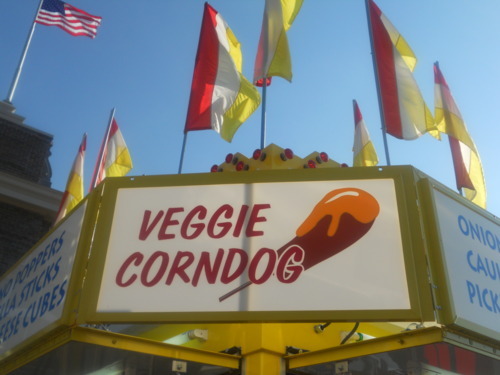
In the early years of cow sculpting, artists used lard. It keeps better at room temperature. Butter was introduced to the art form as early as the 1850s. Tibetan monks used yak butter to create figurines of animals and deities for worship.
Pratt said carving butter cows outside, as I did, is a completely different animal than working in a cooler.
“It’s pretty hard,” she said. “I work in a 42 degree cooler and I have a room outside that is 60 degrees and tempers all my butter. The sun works against you. The people on the stage have a 55 pound block of new butter which is frozen solid. I do additive sculpture so I have armatures (wood and steel underneath). In the competition, you’re carving from a solid block as if you were carving stone. The key is to have a tool that cuts a lot of butter.”
Pratt shares the home cooking duties with her husband. “We use a lot of butter,” she said. “We did have a bit of a disagreement because my daughters thought margarine was butter. We had to set them straight on that. I use more butter when I bake. When I cook I usually use olive oil.”
Pratt looked about the cooler that has provided so many warm memories. She said, “The butter cow is a symbol of agriculture that is so recognizable.
“You can always count on it.”


Leave a Response